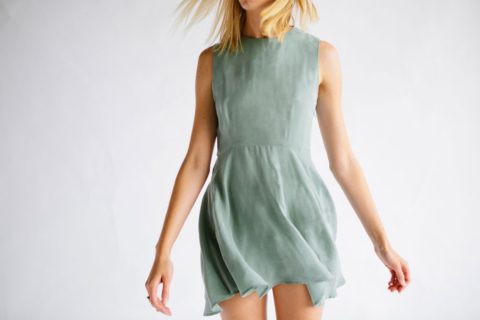How to Shop Ethically: 10 Tips for Reducing Your Fashion Footprint, Now!
Nothing is more disheartening for a fashion lover than to realize that their passion for clothes might have a negative impact on the rest of the world. Even casual shoppers are contributing to the problem more than they may think. The problem, to be specific, is fast fashion. By now it’s common knowledge that the booming surplus of cheap clothing is causing problems worldwide, from poor conditions for factory workers that lead to tragedies such as the collapsed factory in Bangladesh to an unsustainable toll being taken on the earth’s resources.
There is simply too much clothing being made, often in unethical ways. A century ago it was standard for someone to only own a handful of clothing, made well and repaired over and over again so that each item would last for years. Now the average person buys around 65 items of cheap clothes and discards more than 68 pounds of clothing in landfills every year. It’s not sustainable, so if you care about the earth and the people who live in it then you probably agree that it’s time to look for alternative ways to shop.
It may seem overwhelming at first, but the good news is that it’s actually very easy to make small but impactful changes to the way you shop for clothes. Whether you take us up on just one or all ten of our suggestions, you can feel good knowing that you’re making a difference (while still getting your fashion fix).
Learn how to shop at thrift stores.
One of the best ways you can shop ethically is by purchasing secondhand clothing. Unfortunately, many people shy away from thrift stores because of the effort required to sort through the crowded racks of duds before finding treasure. Instead of being intimidated, think of it as a game. Set aside your Saturday so that you can take your time browsing through the racks, and go with a list of items you need in mind. Skip over flimsy polyester and instead look for clothes that were well-made with quality fabrics such as wool, suede, leather, and cotton (this is a great guide for assessing clothing quality). You’ll likely be able to find many sturdy wardrobe staples such as jeans, sweaters, and even coats and shoes for a fraction of their original cost. And, of course, there’s always that special thrift store find that you weren’t looking for that winds up becoming a unique addition to your wardrobe. Be sure to bring things full circle by donating your own clothes when you’re tired of them.
Research ethical clothing brands online.
If you want to buy brand new clothing and your only nearby option is a mall, then it’s time to head to the Internet and discover all the amazing brands that produce clothing ethically and consciously. Here’s a few just to get you started: Eileen Fisher has a great eco-friendly collection of simple, classically stylish clothing. Everlane offers modern basics and complete transparency about how and where their clothes are made. It doesn’t hurt that their clothes, from cashmere sweaters and silk tops to loafers and totes, are beautiful and reasonably priced. Bon George designs and assembles their clothing in L.A., using salvaged materials to create gorgeous tops, skirts, and dresses. Encircled makes travel-ready clothing for women (like a cardigan that you can wear multiple ways) out of eco-conscious materials in Toronto using fairly-paid labor. Finally, OÖM Ethikwear creates clothing for men, women and children in Canada using eco-conscious materials. These are just a few examples–with just a little online digging, you’re sure to find an ethical clothing brand that suits your style and budget.
Research ethical fast fashion brands (they exist!) and stick to them.
The good news is that you don’t necessarily have to eschew fast fashion for good. Some brands are making an effort to offer ethically-made clothing, so be sure to reward those efforts whenever you see them. H&M offers a conscious clothing section as part of their sustainability goals. The ASOS Green Room offers an even larger selection of sustainably-made clothing from eco-conscious brands. Urban Outfitters has a section called Urban Renewal, which is clothing handcrafted in Philadelphia out of vintage or recycled materials.
Budget for high quality staples.
Let’s talk about budget. When switching to an eco-conscious wardrobe, it’s not impossible to stick with the same clothing budget that you used for fast fashion—but it does require an adjustment to how you shop. Suppose you spend a certain amount of money to purchase 30 to 60 items of cheap fast-fashion clothing per year. Now, you’re more likely to spend the same amount of money purchasing only 10 to 30 new items of clothing per year. However, the quality is almost certainly going to be much better and your clothes will last longer, look better, and be worn more. Take a good look at how many fast fashion purchases you made in the past year and ask yourself if they were worthwhile investments. Wouldn’t you rather have one silk top that lasts for years instead of three polyester tops that fall apart in a year? It might be hard to adjust your shopping habits at first but it will be worth it.
Learn about clothing.
You can’t exactly shop for quality, ethical clothing if you don’t know what to look for. Do a little bit of research, either just about clothing in general or a particular brand that you’re interested in. Where does the clothing comes from, who made it, and what should you look for in terms of quality are just a few questions to ask. A great place to start (besides the aforementioned guide to clothing quality) is the book Overdressed by Elizabeth L. Cline. Cline uncovers the truth behind our fast fashion addiction, traveling to China and Bangladesh to see the impact on workers there in addition to the effects on our environment. It’s a gripping and important read. There are also online resources that can educate you and help you stay abreast of eco-conscious news, such as Ecouterre, Ecosalon, and Slaveryfootprint.org.
Ask your favorite brands to do better.
Don’t underestimate the power that you have as a consumer. Obviously you should vote for change with your dollars, by supporting the brands that are eco-conscious and avoiding the ones that are not. However, you should also use your voice. The advent of social media makes it easier than ever to make large brands aware of consumers’ wishes, so hop on Twitter, Instagram, and Facebook to ask your favorite brands to reform. The Internet can be a powerful tool, so be creative and figure out a way to make your voice heard, whether it’s with hashtags, petitions, or a viral video.
Support local small businesses.
Speaking of shopping locally, if you have any small clothing boutiques nearby then they’re a much better bet than your local strip mall. It’s much easier to ask the owner of a small clothing boutique where they source the clothes they sell. Plus you get to feel good about supporting local businesses. Bonus points if that cute little shop on Main Street sells secondhand or handmade clothing.
Take a sewing or knitting class (or learn online).
If you have the spare time and the desire to learn, it’s always a great idea to make your own clothes. It will allow you to be creative and make something totally unique, in addition to teaching you the true value of one item of clothing in terms of the time and work involved. If you can’t find any sewing classes in your area (or can’t afford it), simply teach yourself with the help of online guides and Youtube videos.
Learn how to repair clothing or find a good tailor.
At the very least, you should teach yourself to make minor fixes and changes to your clothes such as patching holes and adjusting hems. This will help your clothes last longer and stop you from running to the mall every time a favorite sweater develops a hole. It’s also a great idea to find a tailor in your area. They can perform both minor and major adjustments to your clothes to help them fit like they were made for you–a necessary service if you’re shopping for clothes secondhand. For helpful tips regarding quick fashion fixes, making your clothes last longer, information about finding a tailor, and more, check out How To Get Dressed by Alison Freer.
Check out Etsy for vintage and handmade items.
If thrift stores aren’t your thing (or you don’t have any in your area), you can turn to Etsy for your clothing needs. It’s easy to lose hours browsing for a unique handmade silk and velvet shawl or the perfect vintage coat from the ‘60s. Not only are you buying an item that hardly anyone else will have, you’re also supporting a small business owner. You can even change your settings to shop locally.








